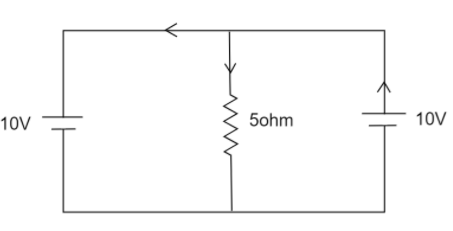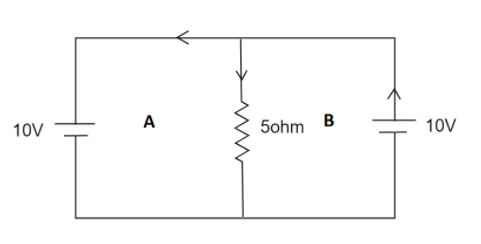
What is current through the $5\Omega $ resistor?

Answer
219.6k+ views
Hint: Here we have a closed-loop of a conductor that we can divide into two elementary loops to simplify the problem. Also, we can use one of Kirchhoff’s laws to figure out our desired answer. Once we learn physics here, then it is a fundamental problem of algebra.
Complete step by step solution:
We take the closed-loop of current and part them into two sections $A$ and $B$ as shown in the figure below-

In both the current-carrying loop, the current is flowing counter-clockwise. So here we use Kirchhoff’s Voltage Law (KVL) to find out the current through the $5\Omega $ resistor.
Kirchhoff’s Second Law or Kirchhoff’s Voltage Law states that the algebraic sum of all the voltages around any closed loop in that circuit equals zero for a series of the closed-loop path.
We assume that the current through the $5\Omega $ resistor is $i$ (ampere).
According to Kirchhoff’s Voltage Law in the loop $A$-
$\Rightarrow 10 - 5i = 0$ ………$(1)$
Since the voltage difference across the resistor $10V$ and $i$ current is flowing through the resistor.
According to Kirchhoff’s Voltage Law in the loop $B$-
$\Rightarrow 10 - 5i = 0$ ………$(2)$
Since here also the voltage difference across the resistor $10V$ and $i$ current is flowing through the resistor.
So from both the above two equations, we can find out the value of $i$-
Hence,
$\Rightarrow 5i = 10$
$ \Rightarrow i = \dfrac{{10}}{5}$
$ \Rightarrow i = 2A$
Therefore, the current through the $5\Omega $ resistor is $2A$.
Note: We can use Kirchhoff’s Second Law, i.e., Kirchhoff’s Current Law, to determine the current at a junction in a closed current-carrying loop. A point of caution, we can only use these laws in a closed loop. These laws are advantageous in complex electric circuits.
Complete step by step solution:
We take the closed-loop of current and part them into two sections $A$ and $B$ as shown in the figure below-

In both the current-carrying loop, the current is flowing counter-clockwise. So here we use Kirchhoff’s Voltage Law (KVL) to find out the current through the $5\Omega $ resistor.
Kirchhoff’s Second Law or Kirchhoff’s Voltage Law states that the algebraic sum of all the voltages around any closed loop in that circuit equals zero for a series of the closed-loop path.
We assume that the current through the $5\Omega $ resistor is $i$ (ampere).
According to Kirchhoff’s Voltage Law in the loop $A$-
$\Rightarrow 10 - 5i = 0$ ………$(1)$
Since the voltage difference across the resistor $10V$ and $i$ current is flowing through the resistor.
According to Kirchhoff’s Voltage Law in the loop $B$-
$\Rightarrow 10 - 5i = 0$ ………$(2)$
Since here also the voltage difference across the resistor $10V$ and $i$ current is flowing through the resistor.
So from both the above two equations, we can find out the value of $i$-
Hence,
$\Rightarrow 5i = 10$
$ \Rightarrow i = \dfrac{{10}}{5}$
$ \Rightarrow i = 2A$
Therefore, the current through the $5\Omega $ resistor is $2A$.
Note: We can use Kirchhoff’s Second Law, i.e., Kirchhoff’s Current Law, to determine the current at a junction in a closed current-carrying loop. A point of caution, we can only use these laws in a closed loop. These laws are advantageous in complex electric circuits.
Recently Updated Pages
A square frame of side 10 cm and a long straight wire class 12 physics JEE_Main

The work done in slowly moving an electron of charge class 12 physics JEE_Main

Two identical charged spheres suspended from a common class 12 physics JEE_Main

According to Bohrs theory the timeaveraged magnetic class 12 physics JEE_Main

ill in the blanks Pure tungsten has A Low resistivity class 12 physics JEE_Main

The value of the resistor RS needed in the DC voltage class 12 physics JEE_Main

Trending doubts
JEE Main 2026: Application Form Open, Exam Dates, Syllabus, Eligibility & Question Papers

Understanding Uniform Acceleration in Physics

Derivation of Equation of Trajectory Explained for Students

Hybridisation in Chemistry – Concept, Types & Applications

Understanding the Angle of Deviation in a Prism

Understanding Collisions: Types and Examples for Students

Other Pages
JEE Advanced Marks vs Ranks 2025: Understanding Category-wise Qualifying Marks and Previous Year Cut-offs

Understanding Atomic Structure for Beginners

How to Convert a Galvanometer into an Ammeter or Voltmeter

Understanding Centrifugal Force in Physics

JEE Main Marking Scheme 2026- Paper-Wise Marks Distribution and Negative Marking Details

Degree of Dissociation: Meaning, Formula, Calculation & Uses




